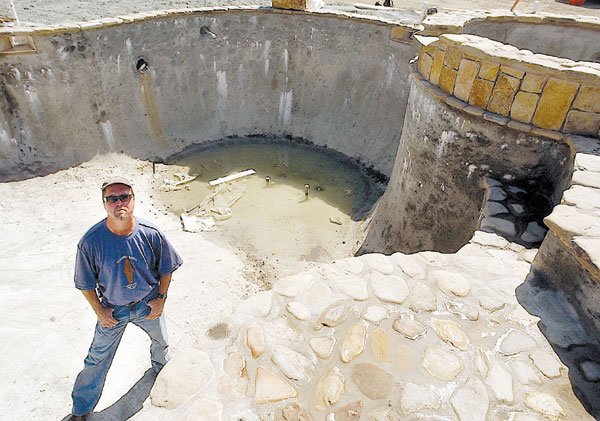Shouts ring out across Todd Renz’s secluded 50 acres as his
13-year-old son jumps from the family’s dive rock, cannon-balling
into the glassy waters below.
He and his friends continue swimming, jumping and soaking until
the afternoon sun’s last rays streak the sky and disappear beyond
the hills at the horizon.
Shouts ring out across Todd Renz’s secluded 50 acres as his 13-year-old son jumps from the family’s dive rock, cannon-balling into the glassy waters below.
He and his friends continue swimming, jumping and soaking until the afternoon sun’s last rays streak the sky and disappear beyond the hills at the horizon.
At least, that’s what Renz envisions. Right now his pool is little more than a glorified hole in the ground, but soon the 45-by-20 foot kidney bean will be finished and filled, just in time for summer.
Installing a pool is time-consuming and costly – starting at around $30,000 to $34,000 for a small, simple style created in a level back yard with easy access for a tractor – but the enjoyment a family gets out of the investment is compounded by the value it adds to their home. In the South Valley, new pool installation has soared, according to Bill Shepherd, pool contractor for Royal Pools, a company based in San Jose that operates a shop in Gilroy.
“Last year we did maybe 40 or 45 pools in San Jose, a city of what? A million people?” said Shepherd, whose company has installed more than 6,000 pools in the greater San Francisco Bay area. “We did over 30 pools in Hollister last year. It was our number two location for the year. In the old days, it used to be areas like Los Gatos and Saratoga doing that, but people down south are putting in a lot of pools now.”
And these aren’t typical white boxes anymore, either.
What most laymen call in-ground pools – pools constructed of a material called gunite, a form of concrete that is sprayed on rather than delivered in a mixing truck – are seeing a renaissance in style as custom looks that go way beyond the typical tile border have become all the rage.
Waterfalls and fountain features are still popular, but the latest trends include exposed rock in a variety of shades and so-called “Shamu shelves” for wading and lounging.
A material called Pebble Tech, an exposed rock surfacing for the pool’s interior, is one of the newest innovations in pool technology captivating consumers. It comes in more than 15 colors from Caribbean blue to Sedona red, allowing homeowners to mix and match the shade of their pool water to the overall look of their home.
“The water is blue colored and whatever else you pick, you mix that color with it,” said Shepherd. “There’s a color called ‘sandy beach’ that’s a tan, and the two mix to an emerald sort of color or if you add red it sort of comes out almost a brownish color.”
One thing a homeowner may love even more than the color of the pool, though, is Pebble Tech’s durability, said Shepherd. Its longevity compared to traditional plaster liners is two to three times as great, he said.
Another hot trend in pool construction is the addition of a “Shamu shelf,” named for the large shallow area for the Sea World’s main attraction, a giant killer whale named Shamu, to slide up on and present himself.
With the Shamu shelf, homeowners can allow their smaller children to play in very shallow water under an umbrella shade. Or they can even put a set of lounge chairs into the pool to give the feel of floating without the risk of being unceremoniously tipped into the chilly water by another swimmer.
Of course, the average backyard set-up isn’t going to rival the grandeur of the most luxe pool Shepherd ever installed, a 70-foot long outdoor version ordered by rapper M.C. Hammer in his hey-day. The unit was complete with a spa and a 1,500-gallon-a-minute waterfall computer-controlled from the telephone in Hammer’s limousine.
That job was $215,000 in 1989. The average pool today costs about $40,000 to $45,000, said Shepherd, and to do a job right, homeowners will have to follow more rules.
All new pools are required to have some sort of protective device installed because of the danger they pose to small children, said Mike Machado, a building official with the San Benito County Building Department. These safety features can be self-closing gates, super-strong pool covers or alarms that sound when a door to the pool area is opened, he said.
“If you put in a gate, it has to be a five feet high, non-climbable type of fence where the vertical posts are no more than four inches apart,” said Machado. “Gates have to be self-closing, self-latching and always open away from the pool, but a lot of people don’t like the look. There are also automatic pool covers that have been safety rated for this type of use. Most of them lock into a track and are extremely strong.”
Homeowner Renz will opt for the only non-structural safety choice, instead, though. He’ll install alarms on the interior doors to match code, but the best defense against drowning, he feels, is teaching his kids to swim.
“Kids will always find a way into the pool area,” he said.
If you’re thinking about installing a pool, here are some of the additional things you should know, according to the booklet, “Before You Dive into Swimming Pool Construction,” by the California Contractors’ State License Board:
n Check on your contractor. Make sure he or she has a valid contractor’s license and take down the number. Builders who install swimming pools must either have a general building license or a swimming pool specialty license. Ask for this number and follow through by calling the CSLB to see if he or she is a current member with workers’ compensation insurance and to see if he or she is the object of any pending legal action.
n Check up on the contractor’s references, too. Get three references and talk to at least one person who recently had a pool installed and one who is in the middle of a build to find out what the contractor is like in terms of timeliness, cleanliness, etc.
n Don’t make inappropriate payments. Never pay for work in advance, and do not deliver the final payment to a builder before the job is completed. It is best to have a record of all payments, so do not pay cash. Also, a pool contractor should not ask you for more than $200 or two percent of the project cost as a down payment.
n Make sure you’re both clear. Do not sign anything if you do not understand the terms entirely, and make sure any final contract is extremely specific in its description of materials. Rather than “six-inch blue tile,” it should read something like “Set blue #6006 ceramic six-inch square, manufactured by California Tile, style #abc, to cover perimeter lip of pool, per plan,” according to the CSLB.
For more information on pool installation, or to reach the CSLB, call (800) 321-CSLB or visit www.cslb.ca.gov. For more information on Royal Pools, call (408) 847-3838.













